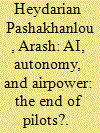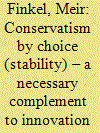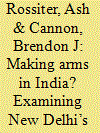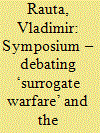|
|
|
Sort Order |
|
|
|
Items / Page
|
|
|
|
|
|
|
| Srl | Item |
| 1 |
ID:
170247


|
|
|
|
|
| Summary/Abstract |
Military pilots have long been central to airpower projection in both combat and non-combat operations. While the historical and contemporary roles of military aviators have been examined extensively in previous scholarship, the present study distinguishes itself by evaluating the future prospects of military aviators. By so doing, it argues that technological advances in autonomy and artificial intelligence (AI) will most likely lead to the development of pilotless aerial vehicles (PAVs), if current technological and social trends persist. In this new order, the military pilot will become a thing of the past.
|
|
|
|
|
|
|
|
|
|
|
|
|
|
|
|
| 2 |
ID:
170250


|
|
|
|
|
| Summary/Abstract |
Military innovation and adaptation are regarded as essential attributes of modern military organizations, while conservatism is condemned. Here I define and exemplify a new kind of conservatism – by choice, according to which military organizations deliberately choose not to change. The argument is twofold. First, a combination of conservatism by choice, innovation, and adaptation will lead to a more balanced and agile force than the current trend that over-emphasizes innovation. Second, conservatism by choice of professional military education, unit organization, and command philosophy will enable better utilization of innovations in the fields of weapon systems and tactical doctrine.
|
|
|
|
|
|
|
|
|
|
|
|
|
|
|
|
| 3 |
ID:
170249


|
|
|
|
|
| Summary/Abstract |
Military training has always been considered as an education system with its own characteristics that distinguished it from the rest of higher education. However, different initiatives have been developed in order to integrate military education in the European Higher Education Area (EHEA). This paper analyses the European system of military institutions of higher education (MHEI). Results indicate MHEI sector has distinctive features that have increased the diversity of European HEIs. Further, the emergence of the MHEI sector can have benefits for both the European defence and their educational attainment. From a defence point of view, it can help the development of a European strategic culture and increase cooperation between countries in defence and security. From the education area modernisation, it will improve defence and security related research and may enhance defence knowledge transfer. In this way, the MHEI sector will be positioned as key player in the development of the Common Security and Defence Policy and a European strategic culture.
|
|
|
|
|
|
|
|
|
|
|
|
|
|
|
|
| 4 |
ID:
170248


|
|
|
|
|
| Summary/Abstract |
When it comes to states arming themselves, it has become axiomatic among scholars of comparative defence industries that go-it-alone production is no longer an option for most. The processes associated with defence-industrial globalization combined with the ever-rising costs of producing leading-edge weapons systems present huge disincentives for autarky in armaments. Against these strong headwinds, however, India has recently launched, as part of a broader, multi-sector initiative called Make in India, a renewed effort to achieve greater self-reliance in armaments production. This article first places India’s recent defence indigenization efforts within wider discussions about states’ armament strategies and trends in global arms production. Secondly, it contextualizes the drivers behind New Delhi’s latest attempts to transform itself from leading arms importer to major producer (and significant exporter) against the backdrop of past efforts which have yielded little but disappointment. Third, it explicates the main facets of the current strategy for defence-industrial indigenization and gauges its chances for success. To preview the main findings, we argue that self-reliance in armaments via indigenous production will almost certainly continue to allude India because of systemic, structural and technological constraints.
|
|
|
|
|
|
|
|
|
|
|
|
|
|
|
|
| 5 |
ID:
170251


|
|
|
|
|
| Summary/Abstract |
In two separate addresses to the United Nations General Assembly, former United States (U.S.) President, Barack Obama, linked the religious wars of the Middle East to the dangers of proxy wars. In September 2014, he acknowledged the long history of religiously motivated wars, and invited the international community to take note of “the destruction wrought by proxy wars and terror campaigns between Sunni and Shia across the Middle East” (Roberts 2014). Two years later, Obama reiterated his earlier concerns warning that “across the region’s conflicts, we have to insist that all parties recognize a common humanity and that nations end proxy wars that fuel disorder” (Oakford and Salisbury 2016).
|
|
|
|
|
|
|
|
|
|
|
|
|
|
|
|
|
|
|
|
|